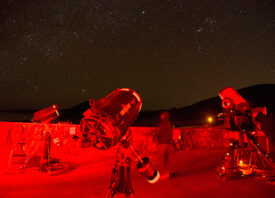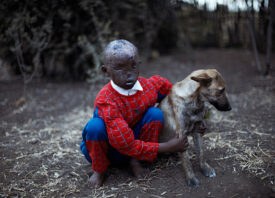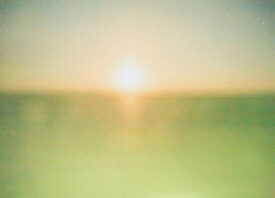Search this site
Talking Lenses With Photographer Jonathan Thorpe

Professional photographer and director Jonathan Thorpe is a leader in the commercial creative industry in Washington, D.C. and across the country. With clientele including BMW, Mercury Records, H&M, CBS, Adidas, MINI COOPER and Red Bull, Thorpe understands what it takes to get the perfect shot.
Before becoming a successful commercial photographer, Thorpe was fascinated by street portraiture. He often wandered about the bustling capital to capture the quirky individuals and stories he found there. Documenting a “Honfest” in Baltimore, Thorpe’s vision for wild colors and outlandish personalities are on full display. Even in his early work, Thorpe always tried to use photography to show another world.
From his personal work to catching the moment when that shiny red BMW slides into view, Thorpe makes it no secret that his most trusted lens is always a Tamron. After falling in love with their 70-200/2.8 lens, Thorpe has been an avid fan of Tamron’s sharp, dependable equipment ever since. An affordable price and dependable build, the lens’ fast aperture and superior color rendition provides the precision necessary to bring each new vision to life. We asked Thorpe to tell us more about his work and why Tamron is his ultimate lens.

Your photography normally has an offbeat/humorous tone. How did you arrive at this personal style?
“I think it’s just my personality really. I’ve always been the ‘funny guy’ for lack of a better term. Comedy has played an important role in my life both personal and professional. Growing up I always admired stand-up comedians, and their ability to make people laugh, which to me is one of the hardest things to do. I also was very aware that comedic tones can play a huge role in advertising. I never wanted to take the ‘pretty’ picture. To me, if someone looks at one of my pictures, smiles, and can forget about whatever they’re going through in their day for just a second, then I’ve done my job.”

Talk to us about your honfest portraits. What is “honfest” exactly?
“Honfest in Baltimore is an annual outdoor festival where a lot of people dress up in 50’s style bright colors. I believe the Baltimore ‘Hon’ is the beehive wearing nagging grandma type. I don’t really have a personal connection to Baltimore, however when I’m there I know I’ll be able to meet some characters, the city is full of them.”
You used to take a lot of street portraiture. Is that something you still like to do in your spare time?
“Street portraiture is where I got my start – I would shoot people very close with a wide angle lens without warning. That resulted in a very ‘startled’ look about them. I really enjoyed it too. Something about interrupting people for a split second in a city that is always moving and is so transient was just interesting to me. I haven’t done it in a very long time, but I’d love to start that up again.”

On a more serious note, “The Renaissance of Heather”, where you photographed a model going through chemo treatments from leukemia, is one of your latest projects. Can you tell us about working with Heather and conceptualizing this shoot?
“I was very fortunate to be friends with Heather on Facebook. One day I reached out to her asking if she’d be interested in doing a shoot. She was bald at the time from her chemo, and I thought doing a beauty shoot would be pretty interesting. So after the phone call I sat thinking to myself, ‘I don’t want to do a beauty shoot.’ After all beauty was not my thing. So after reaching out to me team, my art director Amanda mentioned the ‘Birth of Venus’ painting. As soon as I saw it I knew it would be perfect. We used an old warehouse for the hospital room, and I called a few friends in to play the doctors. The whole shoot was actually pretty fast, I think after we setup we shot for about 20 minutes total before we got ‘the shot’.
“The response has been amazing. Never had I felt what it was like to take a picture and have it impact so many people. I still get emails from people who have seen it for the first time, and they tell me about their mother, or sister, or other family member going through the same thing as Heather, and how they can totally relate.”

The portrait of the lead singer of Baltimore band Phoenix Rising is fantastic. How did you take the shot in order to highlight his freckles so prominently?
“For the portrait of the lead singer, I shot him with a three-light setup. Two side lights to light both sides of his face, and then a beauty dish overhead. I underexposed the shot about a stop and half, then brought the exposure back up in post and sharpened it to bring out the textures and freckles. It was shot with a 24-70/2.8 VC Tamron lens at 70mm.”
How long have you been using Tamron lenses and what do you think sets them apart from others?
“I’ve been using Tamron lenses now for about 3 years. A few things set them apart for me, one being the overall build and lightness of the lens. They’re built very durably, and don’t weigh 9,384,729 lbs. When I’m shooting video, that weight makes ‘run-n-gun’ much easier. Going back to video, the new VC feature of the lenses is amazing. I’ve never been more impressed with image stabilization as I have been with Tamron. I can literally hand-hold and walk with a camera and barely see any shake.”

How many lenses do you own? Can you walk us through which lens you use for specific shots/situations?
“I currently use 6 lenses: Tamron 10-24, Tamron 24-70/2.8 VC, Tamron 70-200/2.8 VC, Tamron 90mm macro/2.8 VC and two fixed focals that rarely come out unless I need really shallow DOF. The Tamron 24-70 stays on my camera 75% of the time. Its great for video, and a perfect focal length. When shooting portraiture I’ll normally use the Tamron 90mm. For me, 90mm is a great length for portrait. The 70-200 comes out a lot in video for far away tracking shots, and if I’m doing catalog work in studio. Oh, and the Tamron 10-24 is used when I want make my friends faces look weird! It’s also great for video.”
Many photographers claim their lens is their “workhorse” item and the one thing in their camera bag they cannot live without. What is the difference, in your opinion, between a good lens and a great/indispensable lens?
“A great lens to me, is one that I can always count on. It will be sharp throughout all the apertures, not too bulky, and overall a focal length that is used frequently. More so than that, a great lens is nothing without a great company backing them.”

This post was sponsored by Tamron.



